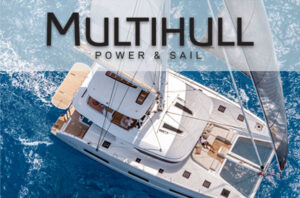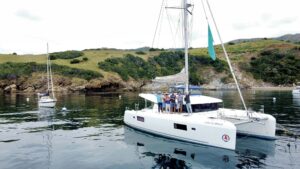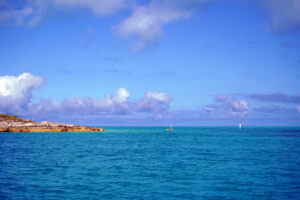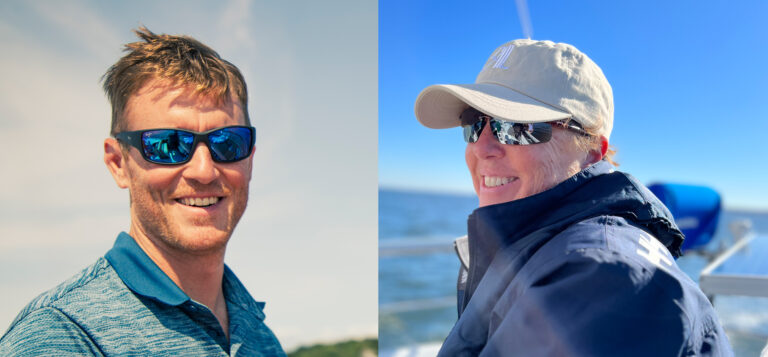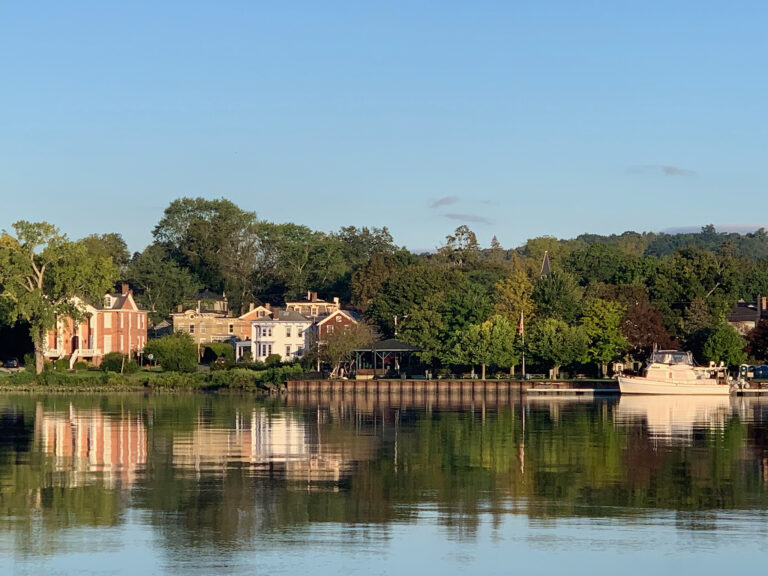
More than just a sailor and designer, James Wharram, originally of Manchester, England, is also both a free-thinker and an individual clearly dedicated to getting as much out of this life as possible. Although he made his mark as a multihull designer, builder and voyager who drew inspiration from the ancient catamarans and proas of Polynesia, such a distinction only scratches the surface of his story—as is evident in the tale of how he came to build his very first catamaran in this excerpt from his recently published autobiography, People of the Sea.
Looking back in time, my “I want to” [build and sail a double canoe across the Atlantic] seems ridiculous, a juvenile fantasy. I was 25-years-old, I had no inherited money, no trade, no profession; I was a dreamer. Ruth [Wharram’s then girlfriend and future wife, who passed away in 2013] sat quietly and replied, “I will help you, but only if you put all your best effort and all your abilities into the project.” Discipline had entered into my life. Then being practical she asked, “How much will it cost?” Around that time there was a small book on sailing by Weston Martyr called The £200 Millionaire, so I quickly said: “Oh about £200,” (£200 in 1954 being approximately equal to £5,500 in 2019, or about $7,500). We sold our Annie E. Evans to two river policemen and returned to England.
On the way back to my parents’ home in Manchester, we stayed in London to visit the Science Museum in south Kensington, with its marvelous collection of Chinese junks and Pacific canoe models. There I found exhibited a model of a 24ft double canoe with a beautiful hull shape made in 1935 by an old Polynesian islander in the Society Islands. I bought a photograph of this model and decided to use this boat as a base for my Polynesian double canoe. At 24ft it could be built within my limited budget.
The hull shape of the model was quite slender, so with this as a starting point I had to redesign the hull shape for loading up with sufficient stores to cross the Atlantic from Britain to the tropical isles of the West Indies, a voyage which would be of similar distance and sea conditions as a long Pacific sea voyage.
A great help in my design research was the Manchester Central Library, which sought out for me a book entitled Canoes of Oceania written by Haddon and Hornell, published in Hawaii in 1936. It was a compendium of all that was known of Pacific canoe-form craft from the past and still in existence in the 1930s, with drawings and descriptions of their construction and sailing observations by the early explorers.

Strangely, the book that gave the minimum design information to me was The Voyage of the Kamiloa by my hero Éric de Bisschop! His brief description of ancient Polynesian design was:
Instinctively I realize why Polynesian sailing craft of old, like those of many islands of today, are shaped like half-moons with lines obviously as fine as possible on account of leeway, but with their submerged lines increasing the displacement…
…it is not so very idiotic; to preserve the mode of construction of the Polynesians, who in their seagoing craft started from the initial principle of the dug-out, adding to it, in order to increase freeboard, as many planks as were necessary…. I have discarded the usual keel; in its stead, a thick beam carved to shape, on the top of which we have nailed the planking of the hull.
With the scant knowledge and experience I had at this time, this gave me no help at all, so I Westernized the beautiful, curved Tahitian canoe, which I had seen in the museum, into a hard edged, long, narrow American dory-style hull. I decided to call my double canoe Tangaroa after the father god in the Polynesian pantheon.
For building material I decided to use 4ft-by-5/8in pine planks, beautiful clear red pine, which were available at reasonable cost; marine-grade plywood was still hard to get and expensive. As they were shorter than the boat, I placed them diagonally on the hull sides—inspired by my sojourn at Thorneycroft, where they built motor torpedo boats using diagonal planking—and crosswise on the flat bottom. Looking now at the structural aspects of the design, I am amazed how much I already understood of the subject. The edge-glued planked hulls, the watertight bulkheads—as used on Chinese Junks and on Kaimiloa—the diagonal bracing on the inner hull sides to prevent hogging, the outer wales to tie it all together, all gave strength with lightness as well as the safety of watertight compartments.

Throughout my wandering years, my father had kept a despairing eye on his disappearing dream of a major Wharram construction firm. Whenever I needed money, he would casually mention that “so and so building firm is setting up a major project. As a laborer you will be sure to get a job,” and I would always get taken on when I applied. Many years later I realized that he must have “put in a word” to the inner group of building project managers. I also suspect the word was “give him a hard time.” I was always at first given the nasty jobs, but when I would say I was leaving, there was frequently a hanging silence that said I should stay, prospects were there.
The building job that I took to raise the money for my Tangaroa was at the construction site of an office block, where they were making a framework of reinforced concrete floors and pillars to be walled in later. In the mid-1950s concrete was delivered from the mixer to the wooden forms by a large two-wheeled barrow, and as a laborer that was my job. When they saw that I understood “structure,” I was moved to being a part of the woodworking team that made the forms out of thick plywood to pour the liquid concrete into. I was unaware at the time that I was learning about the strength and possibilities of plywood as an easy-to-use, hardwearing, loadbearing material.
The ply they used for the concrete shuttering was of Douglas Fir; it looked rough and often had voids in its inner layers. Seeing it covered with releasing oil and concrete, at no time did I think of it as a suitable boatbuilding material. At that time in 1954 plywood was being used for boatbuilding, but it was always a very expensive, tropical hardwood ply, with guaranteed glue and wood specifications, bearing a British Standard kite mark. Such plywood was too expensive for my dreamboat.
In our lunch break we would sit in the site office and while the other navvies were fooling around throwing crusts of bread, I would sit in the corner studying my precious library book Canoes of Oceania. These men may have been rough, but they had kind hearts and always treated me respectfully; they called me the “professor” as I wore glasses and always had my nose in a book.
Working high up on the office block, which was on the edge of town, I could see a small farm. Passing it on my way home one evening I asked the young farmer, “Do you have a shed I could build a small boat in?” He thought it was a great joke, but for a small weekly sum he would clear the chickens out of the loft, and I would have a boatshed, “Providing you can get the boat out of the shed without damaging it.”
Whilst I was pushing loads of cement around, dismantling and re-assembling giant plywood mold boxes, Ruth, with the constraints on her work choices through being an “enemy alien,” [being a native of Germany] worked as a domestic cleaner in the nurses’ accommodation in a nearby hospital. She subsequently said, “It was the easiest job I ever had.”
By March of 1954 we had enough money for me to stop working and begin building in the farm loft. I cleared the chicken shit out, blocked up the gaps in the walls and levelled the floor. Building a small boat alone is like an exercise in meditation; throughout the summer I worked on my dream. The boat could have been built faster, but my father along with his head carpenter would occasionally visit to see my progress. This head carpenter was of the same ilk as the boatbuilders I had worked with at Thorneycroft. Each visit was like an examination.

On her days off, Ruth would come to sand, paint and put her feminine spirit into the boat. She was not the only feminine spirit; another young German girl, Jutta, visiting my English friends came to the boatshed and asked: “Can I help?” To test her sincerity I gave her the unpleasant job of painting inside the small end hold. She did it without complaint. Then one day she said: “I would like to sail the oceans with you.” I knew that my planned voyage across the Atlantic on this small double canoe to prove Thor Heyerdahl’s theories wrong could be very hard and possibly very dangerous for a young outsider. Éric de Bisschop had shown that the double canoe was seaworthy, however his Kaimiloa was 38ft long; my little double canoe was only 23ft 6in. Éric had sailed thousands of miles across oceans even before his double canoe voyage. I was a beginner at offshore sailing and to encourage a young girl to join as crew was not sensible. I pointed out the hardships and danger that we might meet on the voyage. Her answer was: “I was in Berlin when the Russians came, I know and have seen hardships.” At that time the story of these wartime hardships and horrors was not generally known outside Germany. I did not fully realize what, as a girl of 9, she had seen and experienced. So I gave a grudging promise of “maybe” and she returned to Germany. [Jutta would, ultimately join Ruth and Wharram on their voyage.]
By September I had finished the boat in the barn loft, got it down to ground level without damaging the loft or the boat and assembled the two red-painted hulls with their uniting beams on which I laid the slatted decks.
Compared to my adventurous hard living in the mountains, the accommodation on Tangaroa seemed luxurious. Others described it as living in two coffins, or more politely two wardrobes on their sides. I decided to launch Tangaroa on the Thames estuary. From Manchester to Burnham-on-Crouch in Essex was about 200 miles. Some young friends who were starting up in the building trade said if I gave them some help to finish a contract, they would load up Tangaroa on their lorry and transport the boat, Ruth and myself “free” to Burnham.
We loaded up, collected our last gear from my parents’ house and said our goodbyes. Driving down the road I realized I had forgotten something and went back to find my strong, powerful mother weeping. Adventure for sons can be anxiety and sorrow for mothers. However, I grabbed my forgotten gear, joined Ruth and my friends on the lorry and off we went. My building friends had a great time unloading the boat, assembling it and launching it. They drank the launching beer and sped back to Manchester to their next week’s work.
I climbed on board alone. “Hello Tangaroa,” I whispered. Ruth joined me. We looked into the hull compartments—no leaks! Next day Ruth and I together struggled to raise the tall mast. Still sweating, we hoisted the sails, truthfully quite small compared to my later boats. Tangaroa immediately “took off,” leaping forward out of control; I had never experienced such rapid boat acceleration—and, out of control, we rammed her into a mud bank.
Dejectedly, I hauled the sails down, bitterly thinking my design was a failure. Who was I to recover the lost art of Polynesian double-canoe sailing? Ruth made me a cup of tea and began the job of rebuilding [my] ego. Encouraged, we hauled off the mud waist deep in cold muddy water and tried again. This time Tangaroa tacked and tacked again—we had a sailing boat.
But it was late in the autumn and to sail down the English Channel and across the Bay of Biscay would have been tempting the sea gods. On advice we sailed up the River Colne to spend the winter in the waterside village of Wivenhoe, to get jobs and wait until springtime.
I have described how step-by-step I learned aspects of life, boat design and boatbuilding. By chance Wivenhoe gave me my final study course in the attitudes I needed to become an ocean sailor.
Sailing up the river Colne we passed a tall shed-like building, behind which the village of Wivenhoe came into view. We spotted a simple wooden walkway over the mud, to which we tied up and went ashore to a row of small cottages. One had the message “Notice—boats and gear stored at owner’s risk” beside the door.
Out of the cottage came a small, alert white-haired man, wearing a peaked cap and a dark blue fisherman’s sweater, bearded with pipe in mouth. Bob Eves, 80-years-old, was a retired legendary barge skipper who first went to sea at the age of 12 in 1886. He spent most of his life sailing flat-bottomed, leeboard, spritsail barges up to 80ft long. Such sea craft were once a major transport system in the Thames and coastal waters. Their captains were men of legend.
Interviewing him in his small living room as to whether we could moor our boat on his pontoon for the winter, we struck an immediate rapport. He later came to refer to me as his “Mate.” This was an honor. Ruth impressed him just as much, as he later told us she reminded him of his beloved late wife.
Ruth got a job in a small sardine-canning factory; I got a job in the nearby town of Colchester as machine molder in an iron foundry, a job I had done years earlier when I had looked for my dream boat in Sweden. When both of us returned “home,” Bob would have kettles of hot water ready, so we could wash off the grime and fish oil. Then would begin the discussions and reminiscences; from Bob I learned to think as a “Sailorman.”
Bob was not the only man of the sea in Wivenhoe. There was a solicitor in the village, John Donnelly, who in the immediate pre-war years had sailed around the world as bosun’ on a 118ft engineless barquentine called the Cap Pilar. He was a traditional square-rigger ocean sailor. We used to babysit for him, and he showed the concerned attitude of an older brother toward our sailing dreams.
Soon after we arrived in Wivenhoe, the cottage next door to Bob was bought by a tall, gray-haired Mr. Cully as his retreat from a “somewhere upcountry” wife and domesticity. He had been a judge in Siam—now Thailand—where, at the same time as the Cap Pilar was circumnavigating the world, he’d had a 45ft schooner built in the finest teak from the board of the great American schooner designer John Alden. With a crew of four Malays he sailed her to Britain via the Red Sea and the Suez Canal just before the 1939–45 war broke out. At that time not many yachts had made such a voyage. He made his at the same time Éric de Bisschop was sailing his Kaimiloa from the Pacific to France via the Cape of Good Hope.
There was also a dear old man in the village called “Tiny” (John) Howlett, being looked after by his devoted Chinese servant. I still have a copy of his book, Mostly about Boats.
All these men circulated around the Nottage Institute, set up in the 1890s to train local working-boat sailors and transform them into professional yacht crews. There, during that winter, Ruth and I learned how to sew sails in the traditional method, stitching by hand. These experienced small-boat sailors treated us as serious-minded pupils, indeed Wivenhoe at that time was a sea version of the early medieval universities I have described earlier.

People of the Sea, by James Wharram with his partner, Hanneke Boon, is available through Lodestar Books, a UK publisher dedicated to “new and neglected nautical writing” at lodestarbooks.com. You can also find out more about Wharram and his many designs at the web site wharram.com
Photos courtesy of James Wharram
MHS Summer 2021

